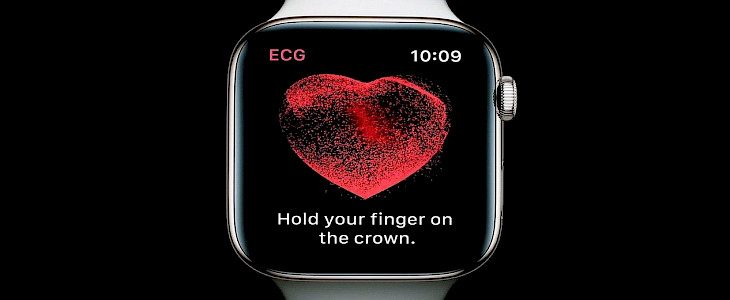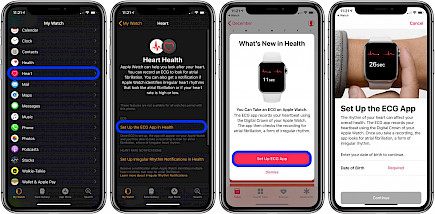
The new Apple Watch is a device built for health freaks. Gone are the days when your Apple Watch could only track steps and heart rate. The new Apple Watch 6 can:
- Track your heart rate and breathing pattern.
- Track your calories.
- Track your blood sugar levels and much more.
But, did you know your apple Watch had a built-in ECG? If the answer is no, be ready to get your mind blown as in this article we are going to talk about the grand ECG feature of the Apple Watch.
So, let us begin.
What is ECG?
An ECG (Electrocardiogram) measures the electrical pulses of the heartbeat to determine if a person's heart is beating at a healthy rhythm or not. According to the American Heart Association, an ECG can detect a problem in the heart by measuring a heartbeat that is irregularly fast or slow.
An ECG is a test that examines 12 parts of the heart. It can be done in a doctor's office to get a solid picture of your health. However, Apple's ECG app only focuses on one. Apple's ECG app is meant to check for only one common heart condition: atrial fibrillation, which is an irregular heartbeat (AFib). AFib, if left untreated, can cause strokes, blood clots, and heart failure.
Setting up ECG through your iPhone's Health app

Setting up the ECG app is as straightforward as navigating through the Health app on your iPhone, and it comes standard or as a software update for newer Apple Watches. To set up an ECG app, click on the browse tab. Next, select Heart. Finally, tap the Set-Up ECG App.
After entering your birth date, you'll be asked to read the information about the ECG app. Then, you'll be asked to take an ECG test. Or, skip it and wait until after set-up.
Measuring your ECG with an Apple Watch

A reading will take about 30 seconds once the ECG app has been set up. Open the ECG app on the Apple Watch. Next, press your finger against the Digital Crown. Apple recommends that you rest your arm on a flat surface, so your wrist is not pressed against the watch's back.
After 30 seconds, one of the four reading results will be shown. You can also add or save symptoms to the reading. If your reading is not normal or worrying, you can export your results to PDF and send them to your doctor.
How to analyze ECG data from an Apple Watch?
After completing your ECG reading, your Apple Watch will display one of four results: atrial fibrillation, sinus rhythm, inconclusive or low or high heart rate.
Sinus Rhythm
Your watch will have measured sinus rhythm if your ECG reading reads sinus rhythm. This means that your heartbeat is in a consistent rhythm of 50 to 100 beats per minute. This reading is normal. However, if you feel unwell or have questions about the reading, you should consult your doctor.
Atrial Fibrillation
Your ECG reading of atrial fibrillation (AFib) means that your watch is measuring an irregular rhythm between 50-120 BPM. This reading is not indicative of AFib and should be checked out by your doctor.
Low or high heart rate
Your watch may have measured an ECG reading that is either low or high in heart rate. This means your watch has detected a heartbeat outside of its normal range, which could be below 50 BPM or higher than 120 BPM.
Although it might sound alarming, this does not necessarily mean that anything is wrong. Low heart rates are common in sleep, extreme athletes, and stress can cause high heart rates. If you are unsure, consult your doctor.
Inconclusive
The last result your ECG app could provide you with is inconclusive. This means that something went wrong while trying to measure your heartbeat. It could be a user error. Perhaps your watch's back was too sweaty, or your arm wasn't supported when you took the measurement. If your pacemaker is not generating enough electrical signals to give a satisfactory reading, it could be inconclusive.
Tips for maintaining a healthy heart rate
A normal and healthy resting heart rate for adults is 60 to 100 beats per minute. It is important to always take care of your heart. You should exercise regularly, eat a healthy diet, and maintain a healthy weight.
You should also plan to see your doctor for regular physicals. It is not only an excellent habit, but it may also aid in the early diagnosis of conditions such as excessive cholesterol or abnormal blood pressure.
You should closely monitor your heart condition and follow your treatment plan. Follow all instructions from your doctor. Report any symptoms that are worsening or new to your doctor immediately.
These are some other preventative tips that will help you keep your heart healthy.
- Find methods to relax and de-stress. Yoga and meditation are two examples of techniques to do this.
- Limit your caffeine intake. Too much caffeine can cause an increase in your heart rate.
- Moderate your drinking, Men over 65 and women over 60 should have no more than one drink each day.
- Stop smoking. Smoking increases your heart rate, and quitting can help bring it back down.
- The side effects of medications should be considered. Certain medications can cause a rapid heartbeat. Before you take any medication, be aware of potential side effects.
Final Words
“Health is Wealth” is a known proverb. The better you treat your body the better it will help you perform and earn. So, it is really important to keep good care of your health to enjoy a prosperous life.
Hope today’s article helped you to learn more about your Apple Watch. Be sure to use the ECG feature on a weekly basis and keep track of your heart’s health.





